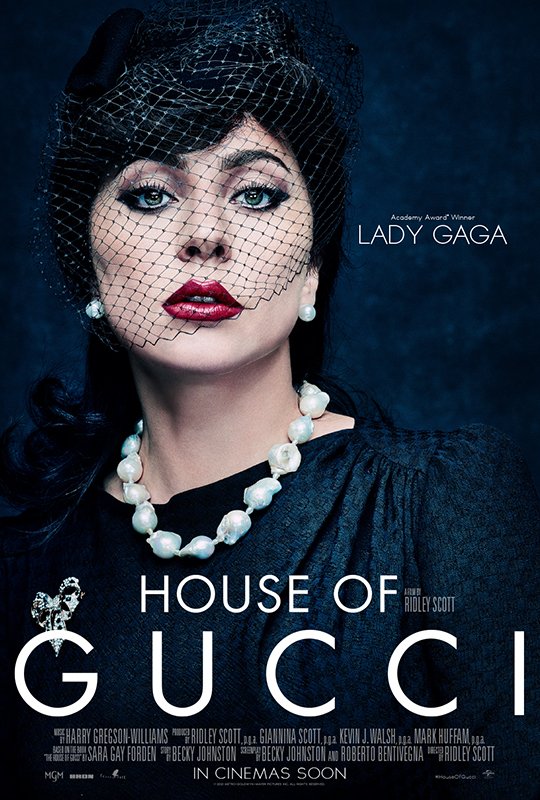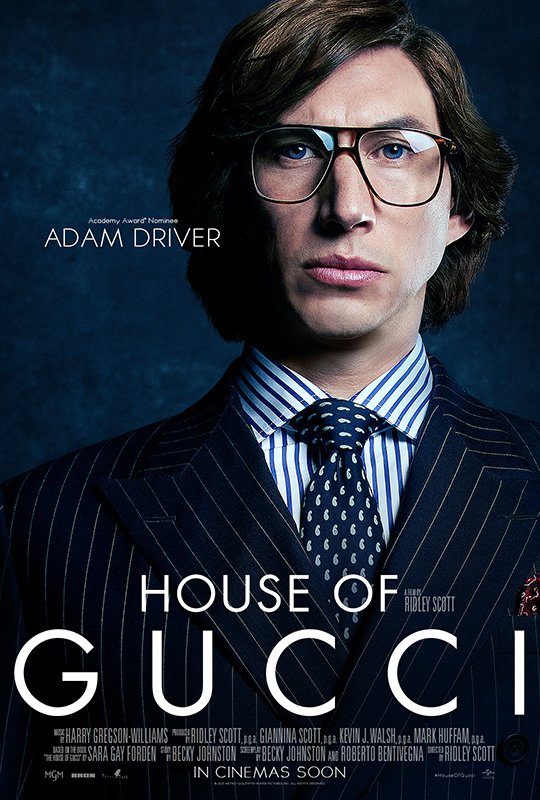HOUSE OF GUCCI - Power and greed Italian-style
Expectations behind House of Gucci were massive. Ridley Scott is not only a cult director; his recent experience at a rich-family saga with an Italian twist - All the Money in the World (2017), about Paul Getty Jr’s kidnapping in 1970s’ Calabria – was seen as a step towards this film.
The cast could not be more charismatic: from Lady Gaga to Adam Driver, Al Pacino, Jared Ledo and Jeremy Irons. The story could not be more enthralling: power, sex, greed and murder: all amongst the inner circle of one of the world’s most famous fashion brands. It felt like an inevitable success in waiting. But was it?
Well, yes and no. It depends on the yardstick. Box office receipts are good, hence no doubt House of Gucci travelled well amongst the world’s audience. But the critical response was underwhelming. A single nomination for Makeup and Hairstyling at the Academy Awards was an awkward sight.
Only Lady Gaga managed to collect a few minor Film Critics’ awards along the way. IMDb’s current rating of 6.8/10 provides a good average between these two extremes: a great film but not a masterpiece.
Watch the trailer
So, what went right and what went wrong?
The four months that have passed since its release provide us with enough distance to return to this film – now available on Amazon – with a critical eye.
Let us start from the positives. The hedonistic lifestyle of the Gucci family is vividly pictured in the film. By the time we meet them, they are an established fashion house, solidly in the hands of its founder’s sons, Aldo and Rodolfo Gucci (Al Pacino and Jeremy Irons).
But what takes centre stage from the very start is the love story between Rodolfo’s son, goofy Maurizio Gucci (Adam Driver), and the bright and aspiring-socialite Patrizia Reggiani (Lady Gaga). The chemistry between the two actors is the driving force of the film, and the first half hour is entirely devoted to their budding relationship: from their chance encounter at a party, to her relentless determination to go out with him, to their sensual relationship and final marriage.
Until then, the film presents none of the spectacular mise en scène for which Scott is rightly famous. This explodes only when the young couple eventually meets the Gucci tribe in a luxury villa on a lake shore. The panoramic zooming in of the camera is accompanied by the loud notes of Figaro’s aria from Rossini’s Barber of Seville.
In many ways the music sets the tone: bombastic but humorous, endearingly boisterous. It’s the celebration of Aldo Gucci’s birthday, and here Al Pacino is closest to a former fictional self: the mafia boss of Coppola’s third Godfather (1990). The scene is caricaturesque and traits of this narrative register remain attached to some of the characters throughout the film.
Thanks to metamorphic make-up sessions which lasted three hours before each take, Jared Leto is turned into Aldo’s son, a farcical Paolo Gucci. Here is a colourful character who takes our suspension of disbelief to its very limit.
At this point the film concentrates on the family’s inner feuds, and Patrizia Reggiani-Gucci turns into the evil mastermind of the lot. Her attempts to take a position of power are relentless once again, and her penchant for bling clothing and hairstyle adds a naff element to this film’s caricature of the rich and powerful.






As mentioned at the start, Lady Gaga is flawless in this interpretation, confirming that her talents shown in A Star is Born (2018) do not need a musical plot and a personal music score in order to shine through. Only, and here the critique starts, she is not given the time to show the flowering of this murderous Lady Macbethian character out of the greedy-but-lovely character she impersonated in the first half hour of the film.
The same happens to Adam Driver’s character, who’s endearing awkwardness as a young man turns into the cold-blooded, megalomaniac confidence of the mature man with little continuity between the two. This is a remarkable (under)achievement, considering that the entire film lasts more than two hours.
The same, after all, can be said of the final part, when Patrizia hires a contract-killer and then finds herself in court being accused of murder. It all happens almost too quickly.
Perhaps the first cut of House of Gucci was three, four hours long and the pruning-to-size was particularly cruel on the second part of the film. Perhaps one day, as it happened with Ridley Scott’s early masterpiece, Blade Runner (2008), a director’s cut will be released and there we will find the continuity and suppleness which is somehow missing.
A final comment concerns the language of the original dialogues. Scott’s decision to have all characters speak English with a strong Italian accent is puzzling. Why?
Of course, Maurizio Gucci and Patrizia Reggiani never spoke to each other in such a language. Nor any member of the Gucci family, unless they were speaking to a foreign person. The result is a “Godfatherish”, Italian-American spin to House of Gucci which baffles the mind rather than help the aesthetic pleasure.
Fortunately, the film’s star-studded cast carries this idiosyncrasy with ultimate professional elegance.
Overall, this is a film well-worth watching, particularly so for our readers, who carry a predilection for Italian subject-matter. There is no denying that, despite Ridley Scott being British, House of Gucci has a distinct Italian-American flavour, and this somehow interferes with the historical dimension of the plot. But Lady Gaga’s presence, in this respect, is a blessing in disguise. As she says, at the start of the film, when Maurizio compares her character to Elizabeth Taylor: “I can assure you. I’m way more fun”.
Cover and images: universalpictures.co.uk







